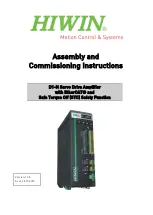
11
English
6.2 Metal loss correction
In many buildings, the metal content in
ceilings and floors is very high . This metal
may cause frequency-dependent loss of field
strength . At a lower limit frequency between
0 .01 Hz and 100 Hz; the loss is 3 dB / octave .
The metal loss correction will counteract
this loss: Frequencies below 1 kHz will be at-
tenuated and frequencies above this value will
be boosted by up to 3 dB / octave . Determining
the effect of metal on the frequency response
requires special equipment; it is difficult and
involves a lot of effort . It is much easier to
monitor the loop signal with an induction
receiver (e . g . LR-202):
Activating and adjusting the correction
feature
WARNING
For activating the metal loss
correction, the unit must be
opened . Therefore, only qual-
ified personnel may do this .
Risk of electric shock!
1) Disconnect the mains plug from the socket .
2) Unscrew the housing cover .
3) To activate the function, place the jumper
J2 in position ON . The jumper can be
found between the microfuse FU2 and
the relay RY1 .
4) Screw on the housing cover again .
5) For the time being, set the control METAL
LOSS CORRECTION (11) to 0 dB .
6) Switch on the amplifier and, in case of
an announcement, set the control METAL
LOSS CORRECTION to optimum speech
intelligibility .
7 Operation
It is not necessary to change the settings
made in chapter 6 . For normal operation, sim-
ply switch on the loop amplifier . Switch on the
units of a PA system in the following order:
1 . the audio units (signal sources)
2 . the PA amplifier
3 . the loop amplifier
To switch off the system, proceed in reverse
order .
7.1 Protective circuit
In case of a fault (failure, overheating), the
red LED PROT (5) will light up and the signal
for the induction loop will be turned off . In
this case, switch off the amplifier and consult
skilled personnel to eliminate the problem .
If the amplifier is overheated due to
insufficient ventilation or extreme ambient
temperature, it may be operated again after
it has cooled down . Improve the ventilation,
if required .
8 Specifications
Induction loop
Loop current: . . . . . . 7 A max .
Admissible
loop resistance: . . . . . 0 .2 – 2
Ω
Max . coverage area: . 200 m
2
Connection: . . . . . . . screw terminals
Inputs
Sensitivity/Impedance; connection
MIC: . . . . . . . . . . . . . 1 .5 mV/10 k
Ω
;
XLR, balanced
Phantom power: . . . . 40 V, to be activated
separately
LINE
XLR: . . . . . . . . . . . . . 630 mV/10 k
Ω
; bal .
RCA: . . . . . . . . . . . . 630 mV/4 .7 k
Ω
,
unbalanced
Frequency range: . . . . 50 – 8000 Hz
Tone controls
BASS: . . . . . . . . . . . . ±10 dB at 100 Hz
TREBLE: . . . . . . . . . . ±10 dB at 10 kHz
THD: . . . . . . . . . . . . . . < 1 %
Ambient temperature: 0 – 40 °C
Power supply: . . . . . . . 230 V/ 50 Hz
Power consumption: . . 150 VA max .
Dimensions
W
×
H
×
D: . . . . . . . . . 482
×
88
×
280 mm
2 rack spaces
Weight: . . . . . . . . . . . 7 .6 kg
Subject to technical modification .
All rights reserved by MONACOR
®
INTERNATIONAL GmbH & Co. KG. No part of this instruction manual
may be reproduced in any form or by any means for any commercial use.












































